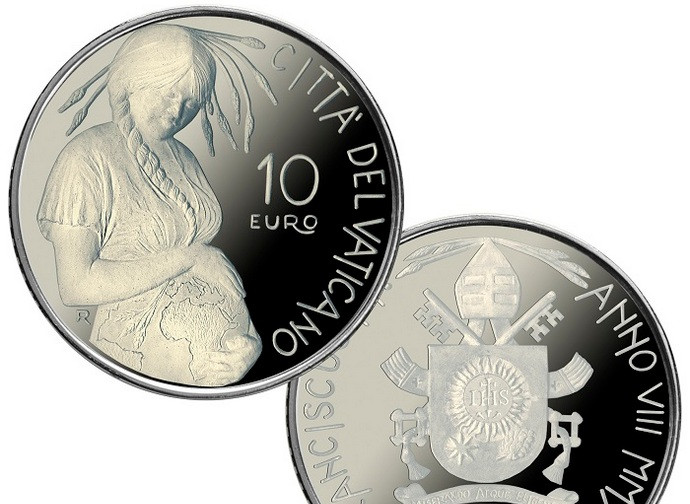The Vatican pays in Pachamama
The Vatican Mint has issued a new €10 silver coin to celebrate Earth Day: engraved on one side, is the image of Mother Earth projecting the iconography of the Pachamama. A scandalous choice: the Catholic Church is paying tribute to a pagan divinity.

“Let me see the coin you pay the tax with”. They handed him a denarius, and he said, “Whose head is this? Whose name?” “Caesar’s”, they replied. He then said to them, “Very well, give back to Caesar what belongs to Caesar, and to God what belongs to God”. (Mt 22: 19 – 22).
Here, instead of Caesar, we have Pachamama, and hence have to give her what is due to her. And this because the Vatican so wills. Here are the facts. On the 16th of October, the Vatican Mint issued a new €10 coin in silver (€69) to commemorate the 50th anniversary of Earth Day. Depicted on one side of this coin is a young pregnant woman whose womb is the planet earth, with some continents represented. Sprouting from her long locks are some ears of wheat.
Here is how the Vatican Numismatic Office explained the meaning behind the minting of this new coin: “The celebration of life on earth is a commitment to take care of the planet. It is the project to which the Church plans to adhere, a grandiose and complex endeavour: promote International action to make sure each person can count on having a future and the food needed in both quantity and quality so economic progress may go hand in hand with social development, without which there is no true progress. The Vatican Mint has issued a €10 coin designed by Master Oldani that depicts a mother bearing in her womb the planet Earth to which we owe both attention and love as if it were a daughter. In this woman’s long hair there are ears of wheat as an evocation between past and future that becomes timeless and hence eternal”.
At the same time the Mint issued other coins. Four are of Catholic inspiration (depicting St. Paul and Raphael), and the fifth is politically correct: St. Peter with outstretched arms welcoming migrants. This fifth coin was minted to commemorate the World Day of Migrants and Refugees.
Let’s return to the pregnant woman on the €10 coin. The “mother who bears the planet Earth in her womb” is obviously Mother Earth, a pagan divinity and not Christian. Mother Earth can be legitimately identified with the notorious divinity Pachamama for a number of reasons: in the Quechua language, Pachamama means Mother Earth; the iconography chosen by Mr. Oldani is a reproduction of the Pachamama (same woman with long hair, caressing her womb); and because Pachamama was recently the centre of attention of senior members of Catholic hierarchies. In fact, approximately a year ago during the Synod on the Amazon, the Indio divinity made a triumphal entrance into the Vatican gardens, followed by two copies of it being placed in the Church of Santa Maria in Traspontina, later ending up being thrown into the Tiber river by very compassionate and Catholic hands allergic to idolatry. The Vatican denied all this, clarifying that the woman depicted is only a symbol of life. That’s tantamount to saying that ‘what’s his name’ is not a criminal, he’s only a crook.
Goddess Mother or Goddess of Life, the fact of the matter is that the jingling of this coin calls to mind that of the thirty coins Judas threw onto the floor of the Temple. First of all because we expect coins minted by the Vatican City State to depict Our Lord, the Most Holy Trinity, saints, sacred scenes or ones celebrating Christian culture (i.e the coins to commemorate Raphael).
What we have here is a blatant replacement: the pregnant Virgin Mary replaced by the pregnant Pachamama. From the sacred to the profane. From something Catholic to something non Catholic, just like what happened a few years ago when, once again the Vatican issued a stamp depicting Martin Luther on his knees before a crucifix and holding a bible in his hand. This was in commemoration of the 500th anniversary of the Protestant Reformation.
Secondly, even supposing we want to celebrate creation (and not the Earth), almost as if we felt the need because no one is doing it, it was indispensable to do so according to a Catholic perspective, a Catholic sensitivity, which means a transcendental perspective where creation is at the service of man and honours not a woman, who, instead of begetting God, gives birth to the world, where God creates the world and does not coincide with the world by becoming a pagan divinity.




